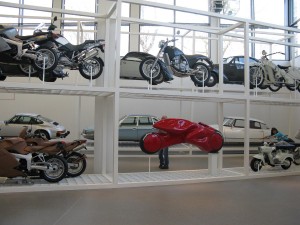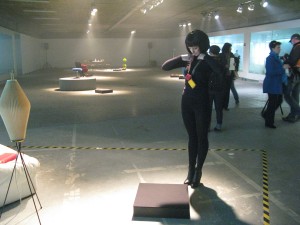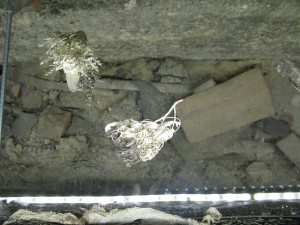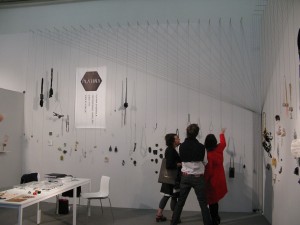Day 5 – Saturday 17 March
Saturday was by necessity a rather less strenuous affair, being the morning after the Academy party, I was the total opposite of bright-eyed and bushy-tailed … perhaps ‘glazed and limp’ would be more apt. I took myself out to the Handwerkmesse where the main Schmuck and Talente exhibitions are. Ever tried to appreciate exquisite jewels by artists who you have long admired when you have to go sit down every 15 minutes? I don’t recommend it (having said that, I wouldn’t hesitate to do the exact same things again in the same order).
So the Schmuck exhibition is beyond belief, it’s a major survey exhibition of international contemporary jewellery held annually in Munich coinciding with the International Handwerkmesse Trade Fair. Over 600 artists from all over the world applied to be in the exhibition and 65 were accepted from 27 countries. Here’s a list of the finalists –
Schmuck 2012 14. – 20.03.2012, Halle A1, 64. Internationale Handwerksmesse München
1 Azubel Iacov, Argentien
2 Bennett Jamie, USA
3 Betz Doris, Deutschland
4 Blank Alexander, Deutschland
5 Blåvarp Liv, Norwegen
6 Braham Frédéric, Frankreich
7 Britton Helen, Australien
8 Bronger Sigurd, Norwegen
9 Buck Kim, Dänemark
10 Chan Jacqui, Neuseeland
11 Cho Sungho, Korea
12 Cook Octavia, Neuseeland
13 Dobler Georg, Deutschland
14 Gianocca Kiko, Schweiz
15 Gralnick Lisa, USA
16 Guttmann Ursula, Österreich
17 Hannon Rebecca, USA
18 Harvey Mielle, USA
19 Ishikawa Mari, Japan
20 Jäschke Margit, Deutschland
21 John Svenja, Deutschland
22 van Joolingen Machteld, Niederlande
23 Kessler Beppe, Niederlande
24 Klarner Sabine, Deutschland
25 Klockmann Beate, Deutschland
26 Knobel Esther, Polen
27 Kruger Daniel, Südafrika
28 Laken Birgit, Niederlande
29 Laurits Kristiina, Estland
30 Lehmann Florence, Frankreich
31 Lieglein Grandpa Wooley, Deutschland
32 Lindner Felix, Deutschland
33 Liu Xiao, China
34 Lorenzen Rüdiger, Deutschland
35 Machatová Jana, Slowakei
36 Maljojoki Mia, Finnland
37 Manilla Jorge, Mexico
38 de Martino Norante Margherita, Italien
39 Minewaki Mikiko, Japan
40 Nagano Nazumi, Japan
41 Ogura Ritsuko, Japan
42 Olšáková Karla, Tschechien
43 Opocensky Pavel, Tschechien
44 Papcun Martin, Slowakei
45 Partington Kathryn, England
46 Pavan Franesco, Italien
47 Peters Ruudt, Niederlande
48 Pontoppidan Karen, Dänemark
49 Puig Cuyàs Ramon, Spanien
50 Sajet Philip, Niederlande
51 Sasaki Katsura, Japan
52 Sequeira Pedro, Portugal
53 Seufert Karin, Deutschland
54 Sibor Jiri, Tschechien
55 Sophocleous Despo, Kanada
56 Speckner Bettina, Deutschland
57 Stach Gisbert, Deutschland
58 Svensson Tore, Schweden
59 Syvanoja Janna, Finnland
60 Terreblanche Carine, Südafrika
61 Truman Catherine, Australien
62 Veenre Tanel, Estland
63 Visintin Graziano, Italien
64 Willemstijn Francis, Niederlande
65 Zimmermann Petra, Österreich
Or you can download the pdf here – Teilnehmerliste 2012
I first saw Schmuck in 2009 when it toured to RMIT gallery in Melbourne. That show blew me away and since then I’d been determined to get to the event in Munich.
Australians were well represented by Helen Britton and Catherine Truman, and also partially by Jacqui Chan a New Zealander doing her PhD at RMIT. I met Jacqui at the Doris Betz class in January at RMIT and she was also in Munich for Schmuck.
Alongside Schmuck is Talente, a similar deal to Schmuck but for young artists and designers under 35. Talente also includes other fields of craft and design as well as jewellery such as objects, glass, ceramics, lighting, furniture and technology.
At 3pm the students from the Munich Academy were drawing their Schmucktombola prizes. This year the students were fundraising to do a class trip to Istanbul to see the treasures of the Topkapi Sarayi (palace) in Istanbul (having just googled the place I now want to go there too, check this out). To do this they sold hundreds of golden tickets, numbered 1 – 1000 for €10 each. The tickets with numbers 1 – 70 would win a piece of contemporary jewellery donated by well-known artists and students. Among the prizes were works by David Bielander, Helen Britton, Laura Deakin, Peter Bauhuis, Lisa Walker, Karl Fritsch, Alexander Blank, Doris Betz, Otto Kunzli, Jiro Kamata & more. I’m sure that I was not the only one there salivating over the prospect of owning Gold Makes Blind by Otto Kunzli for €10. The other tickets 71 – 1000 also all won prizes; catalogues, publications, small jewellery multiples etc. I was extremely lucky to get ticket 67 and got a beautiful brooch made of resin, plastic and silver by Sungho Cho from Korea. Cho was also in Schmuck this year so I was stoked!
After that was the presentation of prizes, I missed the Talente prizes as they were announced first, but I found out afterwards that one of the prizes went to a fabulous designer called Marina Elenskaya from Russia-by-way-of-the-Netherlands who presented some really innovative large neckpieces in crushed glass and latex, go here for images of the works. Marina is a recent graduate from the Rietveld Academie in Amsterdam.
The Herbert Hofmann prizes were won by Alexander Blank and Despo Sophocleous (as I mentioned previously), and also Tore Svensson from Sweden.
After the prizes everyone trucked along for dinner & beer at the Augustinerkellar at Arnulfstrasse 52, the biggest of the many beer halls run by Augustiner Brau in Munich. Augustiner is Munich’s oldest brewery dating from 1328. Here’s a picture of the beer hall filled entirely with Schmuck people, most of them eating Schweinebraten, or roast pork, the local favourite.
Here’s a photo of a waiter with a platter of Scweinebraten.
Once again, many beers were consumed and new friends made. I was introduced to Peter Skubic (and died a little bit) who was totally chuffed that he had fans in Australia!
Day 6 – Sunday 18 March
Sunday began with a lecture by contemporary jewellery commentator Marjan Unger at Die Neue Sammlung – The International Design Museum Munich in the Pinakothek der Modern. I was really lucky to weasel my way in there as it was completely full and others were turned away. Marjan’s talk was on the subject ‘Freedom has its limitations. Jewelry now, seen from a Dutch perspective’. I missed the start but there were also full lecture notes with pictures available for everyone to take away and review in their own time. Its hard to summarise here what she covered, but one of the points which stuck with me, was what she termed the ‘ivory tower mentality’ of the contemporary jewellery community, and how that attitude has failed to bring more recognition to our type of jewellery. She said rather than of thinking of ‘us and them’ – in terms of the greater jewellery world, perhaps it should be ‘all of us’. I’d like to put up a link to her notes but I only have a hard copy and no scanner.
Then I went down to try to look at the International Design Museum and see the contemporary jewellery display in the basement. The International Design Museum is every design student’s wet dream; it has examples of 3D design from every period from the 19th century to now, including furniture, tableware, automobile, & computer design so much more. It nearly broke my heart that I didn’t have time to stop and look properly. I forged ahead to the Danner Rotunda in the basement where there is a permanent display of contemporary jewellery. The current display is curated by Karl Fritsch and opened last year. When I got down there I nearly died all over again. A lovely American I met described it as ‘every most famous piece of contemporary jewellery by every most well known artist that you’ve ever seen in every book’ (or words to that effect), and she was spot on. It was out of control. There were pieces from over 100 artists, probably at least 300 works altogether from the 60s up until now. Watch a video about it here to find out more. It was a little too much for me and I couldn’t take it all in. It really would have needed two visits to truly appreciate everything that was there. It didn’t help that there was no wall labels, only a room sheet that folded out to about A1 size, it was like a blanket, and quite unmanageable to use to figure out who made what piece and the materials used.
This is what you see first when you descend into the International Design Museum.
Part of the automotive display. Can’t tell from the photo but these giant shelves were slightly tilted and lurching to the left and right. Created a great sense of motion.
I then went to the MaximiliansForum again to see a jewellery performance installation. This was a pretty interesting idea of new ways to look at jewellery. The space at MaximiliansForum is very large and the exhibition consisted of several installations delineated by tape on the floor. Within the darkened space each area had its own pool of light containing a few items of furniture, and someone performing an action while wearing jewellery. Unfortunately I was late so I only caught about 3 performances and the other spaces were empty of performers, but displaying the jewellery piece on a cushion. The people standing at the bar were also performing a super slow motion caricature of people drinking & greeting friends with exaggerated facial expressions and gestures, I couldn’t see any jewellery in that one, just lots of red wine.
I did see other shows on Sunday such as the masterful goldsmithing of Michael Becker but the standout for me was Mari Ishikawa’s show at Sparkassenstrasse. I met Mari the night before at dinner and she was such an open and friendly person, she implored me to go to her show, so how could I not? I think the show was called mistake to make, all make mistakes, make mistakes properly, (from what I could understand from the program) . The other artists in the show were Stephanie Muller, Klaus Erich Dietl, Masayo Oda, Gulcan Turna, & Mirei Takeuchi.
The presentation of this show actually took my breath away when I stepped into the room. The space was dark, the only light coming from trenches on the floor. The works were on glass shelves in the trenches and the trenches were then covered with glass. To see the work, viewers had to get down to floor level, on their hands and knees and put their faces right up to the glass. It was like praying. I loved how it forced viewers to physically get on a different level to see the work. The artists had also chosen to leave all the pre-existing debris & cobwebs in the dirt underneath the glass shelves. I believe that these trenches are normally ventilation and are covered with grills. The artists had to fit them out with the glass shelves, glass covers and lighting especially for the show.
You can just see the faces of the people bending down to see the works in the floor in this photo:
I hope that Mari will forgive me for showing a close-up of her work without crediting the title, but its just to show how perfectly suited and appropriate this setting was to her work. Here you can see the brooches sitting on the glass shelf, seemingly hovering above the dirt, rubble and debris behind, as well as the LED strip lighting.
Day 7 – Monday 19 March
On Monday I went back to the Handwerkmesse to have another look at Schmuck and Talente. Also at the fair are stands from well known international jewellery galleries such as Gallery Marzee & Gallery Ra from the Netherlands and Platina from Stockholm. Each gallery has a custom display and brings many pieces to the fair. I loved the display of Platina. They had this ingenious string pulley system to hang the works on the wall.
The strings are tied off in the bottom right corner so all the dealer has to do to retrieve a piece is untie the string to lower it. It was beautiful and functional.








